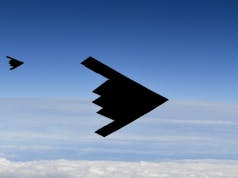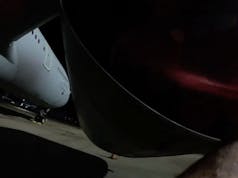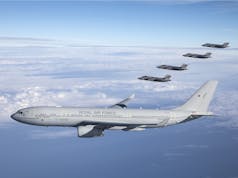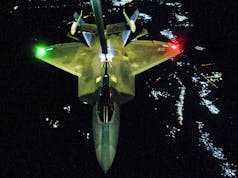Members of Parliament and some analysts have expressed fears that a contract to replace the E-3D Sentry will be handed to US defence giant Boeing without a competitive tendering process.
MP Madeleine Moon, a member of the defence select committee, earlier called for any potential Sentry contract to be bid for in an “open and transparent” way.
“Buying from Boeing forgets the importance of British defence jobs and maintaining this country’s defence industry’s capabilities. By buying off the shelf without an open competition how will we know we will be getting not only the best deal but also the best equipment?”
Options for the future delivery of the UK’s Airborne Warning and Control capability are being explored, including upgrades to the current E-3 Sentry fleet, however some industry commentators are arguing for a new aircraft type altogether.
Madeleine Moon, Chair of the Defence Sub-Committee, asked:
“To ask the Secretary of State for Defence, when he plans to run a competition to replace the RAF’s airborne early warning aircraft.”
Guto Bebb, Parliamentary Under-Secretary of State for Defence, answered:
“No decision has been made with regard to the future delivery of the UK’s Airborne Warning and Control capabilities, although a range of options are being explored. I am withholding details of the level of funding allocated for the future delivery of the RAF’s Airborne Warning and Control System as releasing them would prejudice commercial interests.”
The large sums of money allocated to upgrading the E-3D fleet should be used to purchase a more advanced off-the-shelf aircraft, a defence analyst has argued. Justin Bronk, Research Fellow, Airpower and Technology, outlines options for replacing the E-3 fleet in his paper ‘The Future of Air C2 and AEW: E-3 Sentry, Threat Technologies and Future Replacement Options’:
“The RAF’s E-3Ds need a £2-billion CSP both to bring them to rough parity with current US and French standards by the mid-2020s and to stretch the fleet out to 2035 in the process. However, the E-3, even in modernised form, is no longer a cutting-edge ABM&S system in a world where proliferating long-range missile systems and emerging non-Western low-observable fighters can force it to stay hundreds of kilometres from contested airspace, placing a higher premium on BLOS communications capacity rather than onboard sensors.
Even when it is able to operate closer to the battlespace, the AN/APY-1/2 mechanically scanned radar array common to all E-3s has significant inherent limitations in terms of its ability to detect low-observable, very slow moving and hypersonic threats, unlike more modern AESA-equipped AWACS types already in service with the US Navy and various air forces around the world. An AESA-equipped ABM&S platform with improved communications node capabilities, based on a commercial-derivative airframe, seems a logical alternative option which could provide the RAF with a more capable and efficient alternative to extending the life of the E-3D over the next 20 years.
Such an approach would incur programmatic risk and acquisition and integration costs, but the MoD should examine and weigh these against the expensive work required to extend the E-3D with a view to ensuring the RAF has the best capability possible for the next two decades.”
The Sentry monitors airspace to provide threat detection of adversary aircraft and situational awareness on friendly assets.
Information gathered by the Northrop Grumman APY-2 radar is processed by the mission crew and disseminated via a variety of data links and communication systems. Sentry also has the capability to detect ships, relaying information to maritime aircraft or allied vessels for further investigation. Its electronic support measures equipment enables the E-3D to gather emissions from other radar systems and emitters, enhancing the crew’s understanding of the environment in which it is operating.
Modified with a Westinghouse AN/APY-1 radar system, its antenna covered by a massive rotating radome held over the rear fuselage, the first of two EC-137D prototypes completed its initial flight on February 5, 1972. After an extensive test programme, the E-3A production version entered service in March 1977. Although the type is officially named ‘Sentry’, the USAF designates it E-3 AWACS. Officially designated Sentry AEW.Mk 1 in RAF service, but commonly known as E-3D, the new aircraft differed from the US fleet in its powerplant of more efficient CFM56 engines.











I would have thought that off the shelf is exactly what we should be exploring. This mitigates risk and maintains parity with our most important defence partner if that is the preferred option.
(Chris H) Expenses paid trips to western USA will matter more than mission effectiveness let alone taxpayer value for money
Some might say I am a cynical old sod ….
We need to define exactly what a replacement will be required to do in the future before we specify anything. But whatever the mission is and whatever ‘clever kit’ is therefore needed this is a dead cert for some new A330neo airframes. But second hand A330 (or A340 if more power is needed) aircraft that use British wings, landing gear and Rolls Royce engines anyway will do the job fitted out with entirely UK designed and trusted kit. After all we just bought 30+ year old Boeing 707 based aircraft for our RC-135W Rivet Joint missions so the precedent has been set
While this is another chance to demonstrate UK ingenuity, technology and manufacture the MoD will of course simply ask Boeing how big a cheque they want ….
I hope you are wrong, this mission is ripe for a dusruptive solution.
Come on UKPLC, there is a huge market for an unmanned platform which has
– Human in the loop crtical decisions
– Machine learning detection and recognition
– Air Ceptor defences
– Long range anti air
– That Aussie radar going on the frigates
– BMD upgrade path
How hard can it be? It doesnt even need to be on a single airframe.
We need to be fully compatible with all aspects of future US defense/surveillance/eww etc systems and what better way to go that to buy it all fitted ready to use. Or we could just linger and ponder whilst back seat armchair patriotic optimists forget the mission and end up with a scrap yard fully of aircraft being broken up into recycling parts. LoL
I am old enough to remember the Nimrod AEW debacle; not forgetting the Nimrod Mk4. A conservative estimate of £1 billion compared to less than $750 million for the AWACs. So, before we start saying lets ignore Boeing, what is there that can beat the B737 AEW&C?
“I am withholding details of the level of funding allocated for the future delivery of the RAF’s Airborne Warning and Control System as releasing them would prejudice commercial interests.”
Utter bullshit. Doesn’t prejudice anything except the government/civil service’s desire to keep their incompetence a secret.
And to keep in the industry in the dark for as long as possible even though time and time again that has proved to end badly.
you have no idea what you are talking about.
(Chris H) Not sure declaring your best negotiating position is a good idea in complex contract negotiations …
The b737 is a beast other options could iai EL/W-2085? More radical indigenous ideas off the top of my head- could be harking back to nimrod mk4 – a Sampson radar nose and aft on an a330?! Or Enlarged artisan radar on bombardier aircraft? Some may say crazy, but I guess my point is that some of the latest radar technology is not from the USA and there are a lot of efficient air platforms out there and there should be competition and consideration of the best options. Also if perfected export?
I’ve said everything I need to say on this in two previous posts. My views are well known. Wedgetail is the obvious choice. We should go ahead in short order. All these calls for competition will do is play into politicians’ hands and give them the perfect excuse for procrastinating ad infinitum.
Agree.
At least it gets it done quickly
With you Richard, wedge tail is the obvious choice. No point reinventing the wheel and then spending a fortune again having to upgrade for obsolescence, with the UK having to fund the lot….
We have to think far more about getting the right kit at the right price for our armed forces…
That isn’t going down hugely expensive bespoke solution route.
I don’t think anyone without vested interest would argue in principle against a open tender. The issue is once the policiticans get involved it will become a mess of vested interests.
If a bespoke option is the best option and if the right contract is put into place and the proper risk assessment is done, then great we get a better capability.
Going back to the real world and off the shelf all the way for me.
Steve, I’m not sure how to read your post but I’m certainly not an example of a vested interest. If I was, I’d be pushing an Airbus solution or BAES solution (that’s my background, that and Westland). Normally I would poo-poo a Boeing solution. But in this case I am a pragmatist. 30 years of complex project management, start-up programmes and complex defence solutions following a very short career in the navy, have tought me that if there is something on the shelf, proven, that does the job, works, has got an established customer base and established logistics chain, including probably a user group where you can exchange problems and experiences, you go for it! The only reason not to is if it either doesn’t meet your requirements or for politico/industrial reasons. We don’t make AEW aircraft in the U.K. last time we tried it was a catastrophe. Lots of taxpayers money and time can be wasted. We can’t afford to wait. We can’t afford to waste the meagre funds our defence budget is allocated. I am increasingly impressed the way the Aussies are taking their defence procurement. If it’s good enough for them I’m willing to bet it’s good enough for the RAF. the alternative is Erieye from Sweden. Probably a good system, but I suspect Wedgetail is better. There is also an Israeli (Elta) radar. Elta radars have always been good, but it requires further development and complex integration onto Voyager. No, despite my pro Airbus, pro European bias, this time I think we should do what is best for U.K. Defence and go for Wedgetail.
my point is an open and transparent tender is without a doubt the best approach, in theory. If the wedgetail is the best option, then it should win the tender.
However as we know theory and practice are different things and best for the job / vlaue for money for the military are rarely deciding factors.
doing some fast reading up on the wedge tail and it seems to have a lower radar range and incomplete 365 degree image, plus can control and track less planes.
I wonder if the more modern radar design makes up for these weaknesses or not.
If you read the comments on the other article on the E3D there is a contributor who has debunked the radar coverage issue as being false.
Yes Steve, you’re right. But Wedgetail is bound to have a much lower probability of intercept and be less susceptible to ARMs. It’s probably easier to network into F-35 and updated Typhoon. Also easier to network with future RPAS technology. It’s also easier to do sector scans, has quicker revisit rates and is better at tracking the targets it does detect. Also I suspect it will be better at detecting stealthy, fleeting targets. Range and power is not everything! But I remember that power of transmission was one of the arguments used by some RAF officers for sticking with E3D. Also 360 degree coverage. But you talk to RAAF or Swedish operators of Erieye and they scoff at the whole power/range/360 coverage issue. Also those advocating RPAS solutions would have to contend with even less power, coverage and range. I suppose their counter argument would be that you’d have more and deployed closer to the FEBA. I would dispute that. These RPAS would be very complex and expensive and likely to be unaffordable in large numbers. Also the idea that they could be easily risked simply because they are unpopulated is ludicrous – if your asset is shot down, its shot down – you’ve lost it. Crew or no crew you now no longer have AEW! So my vote is still for Wedgetail. Later when RPAS solutions become more commonplace and affordable they can be integrated with Wedgetail as a technology insertion. Similarly as a force multiplier for Poseidon (although the Aussies are already doing this! God they are so ahead of the game!).
If the RAF get the Wedgetail the Voyagers have get booms.
Yes Patrick. There is a plan. The Airbus ARBS works perfectly well now (thanks to some brilliant Airbus Spanish engineering and the perseverance of the Aussie customer) and could be easily retrofitted to some of our voyagers. But it would actually be easier and cheaper to buy some second hand A330s in very good nick and have them converted to Voyager configuration but with ARBS instead of HDUs. The math has been done. HMG would sell some of its existing spare voyagers as a trade-off. There is a market for these. Airtanker/Airbus ready to go. Only problem is that there is as yet no RAF endorsed operational requirement for this capability so therefore no budget. Lots of talk and interest and studies but as yet no official RAF interest although they will now have Poseidon, probably Wedgetail, C-17 and Airseeker in the inventory.
(Chris H) Richard – you are absolutely correct the ARBS system works well but as I have ventured before the UK has very few Boom / Receptacle fitted aircraft:
8 off C-17 Globemaster
3 off Rivet Joint
Therefore the costs of conversion cannot be justified especially as those that are so fitted have very long range anyway.The RAF Sentry AEW1 has proved that a US Receptacle specification aircraft can be fitted with Drogue and Probe refuelling system. Given the position and design of Receptacles in the top of every aircraft there is no safety, efficiency or other reason why they could not be converted to Probes. Personally I would have the P-8 Posiedon’s so fitted as they are manufactured and make it an RAF / FAA standard. Likewise any new aircraft purchased from the USA
As to what ‘off the shelf’ aircraft would be suitable depends on what the mission specification might be. That is where I have my worries because the MoD are not good at declaring a specification, sticking to it and then putting it out to tender. Whatever is required I think we need something a bit more future proof and capable than a Wedgetail. The RAAF have done a great job but what suits their needs may not suit ours. And I wonder why you doubt that the UK cannot create better radar / scanning systems here in the UK and fit it into an A320neo – an altogether better aircraft than the 737 ever was or will be. But I do suspect we need a larger aircraft and bigger capabilities and therefore why I suggested a converted A330 airframe.
edit (to)
I wonder if the RAF would go down the route of re negotiating the Air Tanker contract to add booms … My guess is not.
You can bet your bottom dollar that Air Tanker have built in excessive and highly lucrative penalty clause’s for any changes to the contract.
Do the RAF sentry fleet even practice AAR these days??
If you ask the men and women at the sharp end of our Defence, they really don’t give a #### were it comes from, they want kit that works well and when its needed.
I can also remember the utter mess that the Nimrod AEW feasco descended into, billions of hard earned tax payers money turned into sad dead hulks littering the RAF Abingdon dump.
Let’s all remember that mess and not try gaffer taping bills Radar onto teds aircraft!
John Clark, not actually correct. See my post above. Airtanker PFI Contract is actually quite flexible and allows for most things. You’ve just got to know your way round the contract which DE&S does perfectly well. It’s convenient to blame the PFI deal though and hide behind that when you don’t want to make difficult decisions. Particularly when PFIs have got such a bad name now (in many cases quite rightly so, but not in others).
Well that does surprise me Richard, I hope you’re right and we can add Carrier borne tanking (eventually) plus booms etc without the public purse being fleeced.
I’d keep the existing aircraft without modification. The increase in capability we’d get for $2B isnt sufficient to justify the opportunity cost. Spend the cash on more fast jets – especially F35Bs. Large AWACS aircraft are increasingly vulnerable to S400/500 systems and very long range AAMs. We need innovative new technology in this area. Networked AEW drones might be a long-term solution worth exploring.
There’s two options for me, Wedgetail and a complete new solution coming from the drone arena. The first is if we decide we need something proven, in short(ish) order and don’t want to pay for huge R&D. The second is if we decide we want a radical solution that will make other sit up and take notice…. and that we want to spend the money on R&D.
I wonder how the Taranis design would cope with the sensor suite needed for AWACS.
I see no mention of the E-2D as a possible replacement. I know the airframe is an old design, but it is still in production and has been updated through its lifetime. As I understand it the performance of the E-2D over water is much superior to the E-3. I think we need to decide where it is likely to operate and proceed from there. As its basically a USN aircraft the A2A refuelling is the same system as used by the RAF.
Its certainly an option worth exploring Paul..